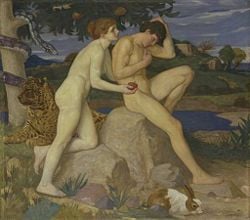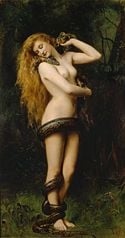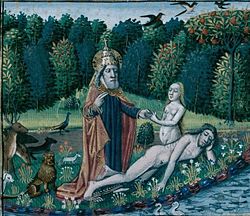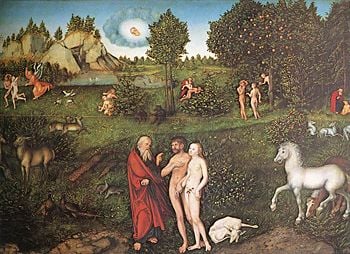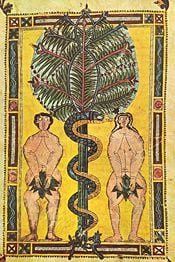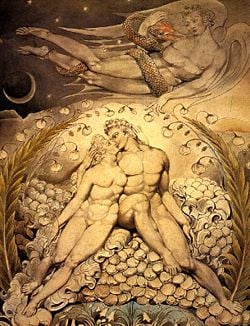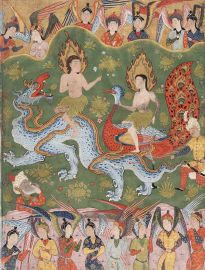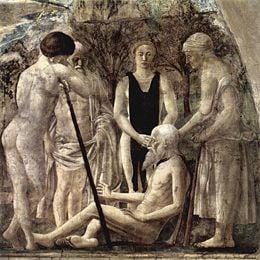Difference between revisions of "Adam and Eve" - New World Encyclopedia
Diana Weber (talk | contribs) |
Diana Weber (talk | contribs) |
||
| Line 63: | Line 63: | ||
[[Image:Adam-eve-priest-animals-river.jpg|thumb|250px|God's creation of Eve from Adam's rib]] | [[Image:Adam-eve-priest-animals-river.jpg|thumb|250px|God's creation of Eve from Adam's rib]] | ||
| − | Only three of Adam's children ([[Cain]], [[Abel]], and [[Seth]]) are explicitly named in Genesis. In [[Book of Jubilees|Jubilees]], two daughters are named: Azûrâ and Awân. Nine other sons are also mentioned, besides Seth, Cain, Abel, making 12 sons and two daughters in all. Jubilees goes on to state that Cain later married Awân, and Seth married Azûrâ. However, according other Jewish traditions, Cain had a twin sister named Lebuda, and Abel a twin sister named Qelimath. In the ''[[Conflict of Adam and Eve with Satan]],'' Cain's twin sister is named Luluwa, and Abel's twin sister is named Aklia. Other | + | Only three of Adam's children ([[Cain]], [[Abel]], and [[Seth]]) are explicitly named in Genesis. In [[Book of Jubilees|Jubilees]], two daughters are named: Azûrâ and Awân. Nine other sons are also mentioned, besides Seth, Cain, Abel, making 12 sons and two daughters in all. Jubilees goes on to state that Cain later married Awân, and Seth married Azûrâ. However, according other Jewish traditions, Cain had a twin sister named Lebuda, and Abel a twin sister named Qelimath. In the ''[[Conflict of Adam and Eve with Satan]],'' Cain's twin sister is named Luluwa, and Abel's twin sister is named Aklia. Other apocryphal accounts give further details of Adam and Eve's life outside of Eden, in particular, the [[Life of Adam and Eve]] (also known as the ''Apocalypse of Moses''). |
As the first man, Adam was traditionally a significant figure to whom was attributed prophecy and wisdom. Some traditions hold that Adam and Eve are currently buried in the [[Cave of Machpelah]], in [[Hebron]], along with many of the great Jewish patriarchs and matriarchs. | As the first man, Adam was traditionally a significant figure to whom was attributed prophecy and wisdom. Some traditions hold that Adam and Eve are currently buried in the [[Cave of Machpelah]], in [[Hebron]], along with many of the great Jewish patriarchs and matriarchs. | ||
| − | In later Jewish [[kabbala|kabbalistic]] tradition arising from the teachings of [[Isaac Luria]], the primordial man, [[Adam Kadmon]] is to be mystically reassembled through the restorative work of ''[[tikkun]]'', in which all mankind will eventually | + | In later Jewish [[kabbala|kabbalistic]] tradition arising from the teachings of [[Isaac Luria]], the primordial man, [[Adam Kadmon]] is to be mystically reassembled through the restorative work of ''[[tikkun]]'', in which all mankind will eventually participate centering on the [[Messiah]]. |
With some exceptions, Jewish tradition does not teach that Adam and Eve's sin was inherited by their descendants. Rather, the tendency to sin, called the ''[[yezer harah]]'' is part of mankind's original nature. God gives his commandments to mankind in order to guide them to overcome this tendency and act righteously. | With some exceptions, Jewish tradition does not teach that Adam and Eve's sin was inherited by their descendants. Rather, the tendency to sin, called the ''[[yezer harah]]'' is part of mankind's original nature. God gives his commandments to mankind in order to guide them to overcome this tendency and act righteously. | ||
| Line 98: | Line 98: | ||
[[Image:Adam and Eve from a copy of the Falnama.jpg|thumb|left|205px|Islamic portrayal of Adam Eve from the "Book of Omens."]] | [[Image:Adam and Eve from a copy of the Falnama.jpg|thumb|left|205px|Islamic portrayal of Adam Eve from the "Book of Omens."]] | ||
| − | Eve is not mentioned by name in the Qur'an, but Islamic tradition refers to her by an etymologically similar name — '''حواء''' (''{{Unicode|Hawwāʾ}}''). In the Qur'an, Adam and Eve eat of the forbidden fruit, but they immediately repent of their sin. Adam is seen as a [[Prophets of Islam|prophet in Islam]] and thus committed no sin after his | + | Eve is not mentioned by name in the Qur'an, but Islamic tradition refers to her by an etymologically similar name — '''حواء''' (''{{Unicode|Hawwāʾ}}''). In the Qur'an, Adam and Eve eat of the forbidden fruit, but they immediately repent of their sin. Adam is seen as a [[Prophets of Islam|prophet in Islam]] and thus committed no sin after his repentance, nor did the sin of the first couple create a "fallen nature" in their descendants. The Qur'an also describes the two sons of Adam—named ''Qabil'' and ''Habil'' in Islamic tradition, but not mentioned by name in the Qur'an—that correspond to Cain and Abel. |
The early Islamic commentator [[Muhammad ibn Jarir al-Tabari]] adds a number of other details.<ref>[http://www.islamic-awareness.org/Hadith/Ulum/israel.html On The Transmitters Of Isra'iliyyat]</ref> For example, according to Tabari's account, after receiving the breath of God, Adam remained a dry body for 40 days, then gradually came to life from the head downwards, sneezing when he had finished coming to life. | The early Islamic commentator [[Muhammad ibn Jarir al-Tabari]] adds a number of other details.<ref>[http://www.islamic-awareness.org/Hadith/Ulum/israel.html On The Transmitters Of Isra'iliyyat]</ref> For example, according to Tabari's account, after receiving the breath of God, Adam remained a dry body for 40 days, then gradually came to life from the head downwards, sneezing when he had finished coming to life. | ||
Revision as of 16:17, 28 August 2007
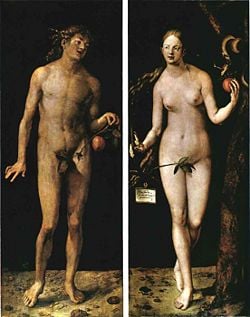
Adam (Hebrew: אָדָם, Adam, "man"; and Eve (Hebrew: חַוָּה, Ḥavva, "living one") were the first man and woman created by God, according to the Bible and the Qur'an.
The story of Adam and Eve is told in the early chapters of the Book of Genesis, which describes the creation of man and woman, the temptation and the Fall, the expulsion from Eden, the story of first murder, and the subsequent peopling of the world outside the Garden of Eden.
Adam and Eve's story underwent extensive elaboration in later Abrahamic traditions, and modern textual scholarship continues to analyze its composition and examine its supposed relationship with earlier Sumerian mythology.
The story has provided many of the most important symbols in Western culture, including the Garden of Eden, the Tree of Life and the Tree of the Knowledge of Good and Evil, the forbidden fruit, and the serpent as Satan. It also provides much of the scriptural basis for the doctrine of Original Sin, an important belief in Christianity which is not generally shared by Judaism and Islam. The story of Adam and Eve is central to the teachings of Unificationism, which holds that the restoration of the ideal that God intended for the first human couple is the providential purpose of human history.
Biblical account
The creation of man and woman
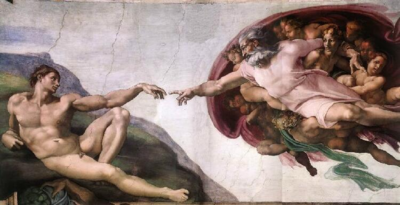
The story of Adam and Eve begins in the first chapter of the Book of Genesis, but the couple is not referred to here by name. Instead, the text speaks of God's deciding to "make man in our image, in our likeness." The creation of man and woman takes place after six "days" of creation in which God first brings into being the heavens and the earth, light, day and night, sky and sea, dry land, trees and other vegetation, the sun and the moon, sea creatures and birds, and finally livestock and wild animals. The manifestation of God's image in "man" is both masculine and feminine:
- So God created man in his own image,
- in the image of God he created him;
- male and female he created them. — Gen. 1:27
God proceeds to bless the couple to "Be fruitful and increase in number; fill the earth and subdue it. Rule over the fish of the sea and the birds of the air and over every living creature that moves on the ground." (Gen. 1:28) God gives them "every tree that has fruit with seed in it" to eat. At the conclusion of this sixth day of creation God declares His work to be "very good" and proceeds to rest on the seventh day.
The account of chapter 2 of Genesis is seen by many scholars as a distinct narrative from a different source. Among several differences between the two accounts, in Genesis 2 God is no longer called Elohim, but is referred to as Yahweh, translated as "the Lord" in most English versions. Here, for the first time, the man and woman are named as Adam and Eve. Also, in this account, no tree or shrub has been made to grow yet when Adam is created. God forms Adam out of clay and places him in the Garden of Eden. Then He causes all kinds of trees to grow in the Garden, including two special trees: the Tree of Life and the Tree of Knowledge of Good and Evil. Here, Adam is not free to eat of any tree he wishes, as he was in chapter one. Instead God commands that he must not eat of the Tree of the Knowledge of Good and Evil, warning him that "In the day you eat of it, you will die." (Gen. 2:17).
Seeing that Adam is alone, God creates Eve out of his rib (Gen. 2:22). Adam then names the animals and also calls Eve "woman." They are both "naked and unashamed."
The fall of man
For an unspecified period of time, Adam and Eve obey the one commandment they have been given, to refrain from eating of the forbidden fruit. However, one day, a serpent comes to Eve and seduces her into partaking of it. "God knows that when you eat of it your eyes will be opened," he tells her, "and you will be like God, knowing good and evil." The serpent shows Eve that the fruit is "good for food and pleasing to the eye, and also desirable for gaining wisdom," so she eats it. She then gives some of the fruit to Adam, and he, too, eats. Adam and Eve immediately realize that they are naked, and become of ashamed of this, using fig leaves to cover their sexual organs.
Soon, God walks through the Garden looking for Adam and Eve, but he cannot find them, because they are hiding from Him. God calls out to Adam: "Where are you?" (Gen. 3:9) Adam responds, "I heard your voice, and I was afraid, because I was naked." God replies: "How did you know you were naked? Did you eat of the fruit of the tree I told you not to eat of?" Adam admits his disobedience but blames it on Eve, and Eve in turn blames it on the serpent.
As a result of these events, God curses all three of the characters in the drama: the serpent must crawl on his belly and eat dust; the woman must suffer increased pain in childbearing and be ruled by her husband; and the man must labor for his food instead of eating freely of what grows in the Garden, for the land too is cursed.
God then confirms the serpent's prophecy to Eve: "The man has now become like one of us, knowing good and evil." (Gen 3:21) To prevent Adam from also partaking of the Tree of Life and living forever, God casts him out of the Garden, posting cherubim and a flaming sword to guard the entrance. However, Adam and Eve do not die as God has told them they would, at least not physically.
Life outside of paradise
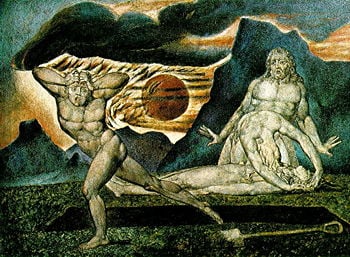
Adam and Eve now commence their lives outside of Eden and begin to raise a family. Their first child is called Cain, and their second is named Abel. After they grow up to the point of being able to establish a livelihood for themselves, Cain becomes a farmer, while Abel is a shepherd. Later, the two brothers each offer a sacrifice to God: Cain brings an offering of his crops, while Abel offers a sacrifice from his flocks. God accepts Abel's offering but rejects Cain's. As a result, Cain becomes dejected. God warns Cain that he must overcome his feelings, for he too will be accepted. However, Cain is unable to change his outlook. Instead, he lures Abel into the field and kills him. Cain flees to the east, where his wife—not previously mentioned—gives birth to Adam and Eve's first grandson, Enoch.
After this, Adam and Eve themselves have another son, Seth, and Eve declares "God has granted me another child in place of Abel, since Cain killed him." After Seth grows to maturity, he becomes the father Enosh. It is Seth's line that produces Noah, through whom mankind's lineage is perpetuated after the Great Flood.
A separate account of Adam's genealogy is given in Genesis 5. Here, neither Cain's nor Abel's lineage is mentioned. It is therefore presumed that Abel died without children. This account specifies that Adam was 130 years old when he became the father of Seth. It is also claimed that Adam lived 930 years before he himself died. Although Eve is not mentioned in this genealogy, in Gen. 3:20 she is given the title "the mother of all living." Genesis 5:4 refers to other sons and daughters of Adam, but does not name them.
Later Abrahamic traditions
Jewish traditions
Jewish traditions tell many tales about Adam and Eve and the aftermath of the story of Gen. 1-2. In the Slavonic Book of Enoch (24:4), Eve became the lover of Satan in the Garden of Eden, and another tradition holds that Satan was the father of Cain (Pirḳe R. El. 13). On the other hand, as soon as Adam beheld Eve, he embraced and kissed her. In this version, when God blessed Adam and Eve in marriage, the angels danced and beat timbrels and stood guard over their bridal chamber. Also, the reason why Eve gave the forbidden fruit to Adam is that she was afraid that she would die and Adam would take another wife (Pirḳe R. El. 12-13).
Even in ancient times, however, the presence of two distinct accounts in Genesis was noted with some curiosity. The first account says "male and female He created them," whereas in the second account God created Adam first and later brought Eve forth from Adam's body, because Adam was lonely. To resolve this apparent discrepancy between the two chapters, some rabbis suggested that chapter one's "woman" and chapter two's "Eve" were two separate individuals.
Preserved in the ancient midrashic accounts and the medieval Alphabet of Ben Sira, this rabbinic tradition held that Adam's first wife, called Lilith, refused to take the submissive position to Adam in sex, and eventually fled from him, consequently leaving him lonely. In some accounts, she goes on to become a demon responsible for much mischief throughout history.
Some rabbis believed that half-human demons arose from Eve's having sex with male spirits (Hag. 16a). In another talmudic tradition, ghouls and demons are engendered by Adam's ejaculations during a 130-year period of separation from Eve. Elsewhere, Lilith is also identified as the mother of these satanic creatures. The demons were said to prey on newborn males before they had been circumcised, and so a tradition arose in which a protective amulet was placed around the neck of newborns.
The Alphabet of Ben Sira identifies a third wife, created after Lilith deserted Adam but before Eve. This unnamed wife was purportedly made in the same way as Adam, from the "dust of the earth," but the sight of her being created proved too much for Adam, and he refused to go near her.
Genesis does not say how long Adam and Eve were in the Garden of Eden, but the Book of Jubilees states that they were removed from the Garden on the new moon of the fourth month of the eighth year after creation (Jubilees 3:33). Other Jewish sources, however, assert that Adam and Eve remained in the Garden for a very short time, even less than a day.
Another Jewish tradition is that God originally created Adam as a hermaphrodite (Midrash Rabbah, Genesis 7:1) so that Adam was both male and female. God later decided that "it is not good for him to be alone," and brought the feminine Eve out of Adam, leaving Adam as masculine only.
Only three of Adam's children (Cain, Abel, and Seth) are explicitly named in Genesis. In Jubilees, two daughters are named: Azûrâ and Awân. Nine other sons are also mentioned, besides Seth, Cain, Abel, making 12 sons and two daughters in all. Jubilees goes on to state that Cain later married Awân, and Seth married Azûrâ. However, according other Jewish traditions, Cain had a twin sister named Lebuda, and Abel a twin sister named Qelimath. In the Conflict of Adam and Eve with Satan, Cain's twin sister is named Luluwa, and Abel's twin sister is named Aklia. Other apocryphal accounts give further details of Adam and Eve's life outside of Eden, in particular, the Life of Adam and Eve (also known as the Apocalypse of Moses).
As the first man, Adam was traditionally a significant figure to whom was attributed prophecy and wisdom. Some traditions hold that Adam and Eve are currently buried in the Cave of Machpelah, in Hebron, along with many of the great Jewish patriarchs and matriarchs.
In later Jewish kabbalistic tradition arising from the teachings of Isaac Luria, the primordial man, Adam Kadmon is to be mystically reassembled through the restorative work of tikkun, in which all mankind will eventually participate centering on the Messiah.
With some exceptions, Jewish tradition does not teach that Adam and Eve's sin was inherited by their descendants. Rather, the tendency to sin, called the yezer harah is part of mankind's original nature. God gives his commandments to mankind in order to guide them to overcome this tendency and act righteously.
Christianity
However, the story of Adam and Eve also forms the basis for the important Christian doctrine of Original Sin: "Sin came into the world through one man and death through sin, and so death spread to all men because all men sinned," said Paul of Tarsus in his Epistle to the Romans, writing about 58 C.E. Later theological commentators more directly connected Adam and Eve's disobedience to God's word as the foundation of mankind's sinful nature.
St. Augustine of Hippo (354-430) understood Paul to have taught that Adam's sin was hereditary. Augustine held that Original Sin passed on generationally through the father's sperm in the act of sexual intercourse.
Over the centuries, a system of other uniquely Christian beliefs has developed from the Adam and Eve story. Baptism has become understood as a means of washing away the stain of Original Sin in Catholic and some other traditions. In other branches of Christianity, baptism is a means of cleansing only the sins that were actually committed by the person being baptized. Additionally, the serpent that tempted Eve is generally interpreted in Christianity to be Satan. This is also true in some Jewish accounts, but in Christian tradition it is the generally accepted belief.
Because Eve had tempted Adam to eat of the fatal fruit, several of the early Fathers of the Church held her and all subsequent women to be especially responsible for the Fall. "You are the devil's gateway," Tertullian told his female listeners in the early second century. [1]
The New Testament also teaches that Jesus is the new Adam who brings regenerating life to Christians. As Saint Paul wrote in 1 Corinthians 15:45-47:
| “ | The first man Adam became a living being; the last Adam, a life-giving spirit. The first man was of the dust of the earth, the second man from heaven. | ” |
However, there is no mention of a new Eve in the New Testament. In Catholic tradition, Mary, the mother of Jesus, is seen as restoring Eve's sin by her giving birth to Jesus as a virgin. Justin Martyr, (165 C.E.) wrote, "Christ became a man by a virgin to overcome the disobedience caused by the serpent ...in the same way it had originated." (Dialogue with Trypho) Irenaeus of Lyon stated: "The knot of Eve's disobedience was loosened by Mary's obedience." (Adv. haereses, 3:22) And Ambrose of Milan (397 C.E.) said, "It was through a man and woman that flesh was cast from paradise; it was through a virgin that flesh was linked to God."
Gnostic traditions
In certain forms of Christian Gnosticism the creation of Adam as Protanthropos—the original man—had a very important place. As in some rabbinical traditions, the Apocalypse of Adam suggests that man and woman were originally conjoined in a single androgynous being, both male and female. This primordial "man" was greater than the eternal angels and higher even than Samael, the god of the Aeon and Powers that had created them. Samael then separated the male Adam from the female Eve, causing their superior knowledge of God to be lost. The Protanthropos is also sometimes seen as a spiritual emanation from God, called the Son of God, which appeared to mankind as Jesus.
In a similar vein, though without reference to the above cosmology, the Gospel of Thomas quotes Jesus as saying: "When you make the two into one, and when you make the inner like the outer and the outer like the inner, and the upper like the lower, and when you make male and female into a single one... then you will enter [the kingdom]."
Some Gnostics adopted the Marcionite belief that the wrathful Yahweh of the Old Testament and the loving Heavenly Father of Jesus were two separate divinities. Gnostic accounts—particularly those of the Ophites—also turned the identification of the serpent with Satan on its head, seeing the serpent as a hero who was trying to help the first couple gain knowledge to defeat Samael, whom some Gnostics saw as the jealous demiurge of the creation.
Islamic tradition
The Qur'an tells of آدم (ʾĀdam) in the surahs al-Baqara 2:30-39, al-A'raf 7:11-25, al-Hijr 15:26-44, al-Isra 17:61-65, Ta-Ha 20:115-124, and Sad 38:71-85. When God orders the angels to bow to Adam one of those present, the Jinni Iblis refuses, due to his pride, and assumes the role of Shaitan, the tempter.
Eve is not mentioned by name in the Qur'an, but Islamic tradition refers to her by an etymologically similar name — حواء (Hawwāʾ). In the Qur'an, Adam and Eve eat of the forbidden fruit, but they immediately repent of their sin. Adam is seen as a prophet in Islam and thus committed no sin after his repentance, nor did the sin of the first couple create a "fallen nature" in their descendants. The Qur'an also describes the two sons of Adam—named Qabil and Habil in Islamic tradition, but not mentioned by name in the Qur'an—that correspond to Cain and Abel.
The early Islamic commentator Muhammad ibn Jarir al-Tabari adds a number of other details.[2] For example, according to Tabari's account, after receiving the breath of God, Adam remained a dry body for 40 days, then gradually came to life from the head downwards, sneezing when he had finished coming to life.
The Shiite commentator Al-Qummi records the opinion that Eden was not entirely earthly. Having been sent to earth after eating the forbidden fruit, Adam and Eve first arrived at mountain peaks outside Mecca—Adam on Safa, and Eve on Marwa. In this tradition, Adam remained weeping for 40 days, until he repented, at which point God rewarded him by sending down the Kaaba and teaching him to perform the Islamic duty of the Hajj.
Historicity
Adam and Eve are considered in evangelical Christianity and Orthodox Judaism as real historical people. Genesis 5:4 records Adam within a genealogy, and in the New Testament, the Gospel of Luke (chapter 3) traces Jesus' lineage all the way back to Adam. Thus, in the biblical tradition, all human beings are descended from Adam and Eve.
However, many modern biblical scholars consider the story of Adam and Eve as an example of a myth, whose importance is in the lessons it conveys rather than the historical reality it supposedly describes. In this interpretation, the narrative's purpose is to convey the origin of sin and human rebellion against God, as well as several less important truths, such as:
- why people are ashamed of being naked
- why people die
- why the snake crawls on its belly
- why women suffer so much during childbirth
- why men must work hard to make a living
- when people started killing each other
- why shepherds and farmers don't get along with each other
The historical-critical school of biblical interpretation emphasizes that the two stories of Adam and Eve in Genesis 1 and Genesis 2 are actually quite different from one another. In the first story, derived from Babylonian creation myths, the world is "good," man and woman are "very good," God blesses the first couple to multiply and rule the earth, and there is no commandment to refrain from eating the fruit of any of the trees of creation. In the second story, probably designed in opposition to Canaanite mother-goddess worship, a certain fruit is forbidden, an evil serpent lurks in the Garden waiting to tempt Eve to sin against God, and the world is not "very good" after all.
In modern times the theory of evolution has also challenged the Christian belief in the historicity of Adam and Eve. Many denominations no longer insist that Adam and Eve were the literal parents of humankind, while others have retained a belief that the story is true as written. Some see a confirmation of the biblical account in the recent identification by geneticists of pre-historic individuals dubbed "Y-chromosomal Adam" and "Mitochondrial Eve." However, these two individuals are not thought by the scientific community to be the biblical Adam and Eve. Indeed, Mitochondrial Eve—the common matrilineal ancestor of all humans alive today—lived many millenia before Y-chromosomal Adam.
Notes
ReferencesISBN links support NWE through referral fees
- Cassuto, Umberto, From Adam to Noah. Jerusalem: Magnes Press, 1978. ISBN 965223480X
- Kikawada, Isaac M. & Arthur Quinn, Before Abraham was – The Unity of Genesis 1-11. Ignatius Pr; Repr. ed., 1989. ISBN 9780898702392
- Lacocque, Adre. The Trial of Innocence: Adam, Eve, and the Yahwist. Wipf & Stock Publishers, 2006. ISBN 978-1597526203
- Morris, Henry M., The Genesis Record: A Scientific and Devotional Commentary on the Book of Beginnings. Baker Books, 1995. ISBN 9780801060045
- Pagels, Elaine. Adam, Eve, and the Serpent. Vintage, 1989. ISBN 978-0679722328
- Schearing, Linda S. Eve & Adam: Jewish, Christian, and Muslim Readings on Genesis and Gender. Indiana University Press, 1999. ISBN 978-0253212719
- Ratzinger, Joseph Cardinal (now Pope Benedict XVI), In the Beginning. Wm. B. Eerdmans Publishing Co, 1995. ISBN 978-0802841063
- Zornberg, Avivah Gottlieb The Beginning of Desire: Reflections on Genesis. Jewish Publication Society of America; 1st ed., 1995. ISBN 9780827605213
Credits
New World Encyclopedia writers and editors rewrote and completed the Wikipedia article in accordance with New World Encyclopedia standards. This article abides by terms of the Creative Commons CC-by-sa 3.0 License (CC-by-sa), which may be used and disseminated with proper attribution. Credit is due under the terms of this license that can reference both the New World Encyclopedia contributors and the selfless volunteer contributors of the Wikimedia Foundation. To cite this article click here for a list of acceptable citing formats.The history of earlier contributions by wikipedians is accessible to researchers here:
The history of this article since it was imported to New World Encyclopedia:
Note: Some restrictions may apply to use of individual images which are separately licensed.
